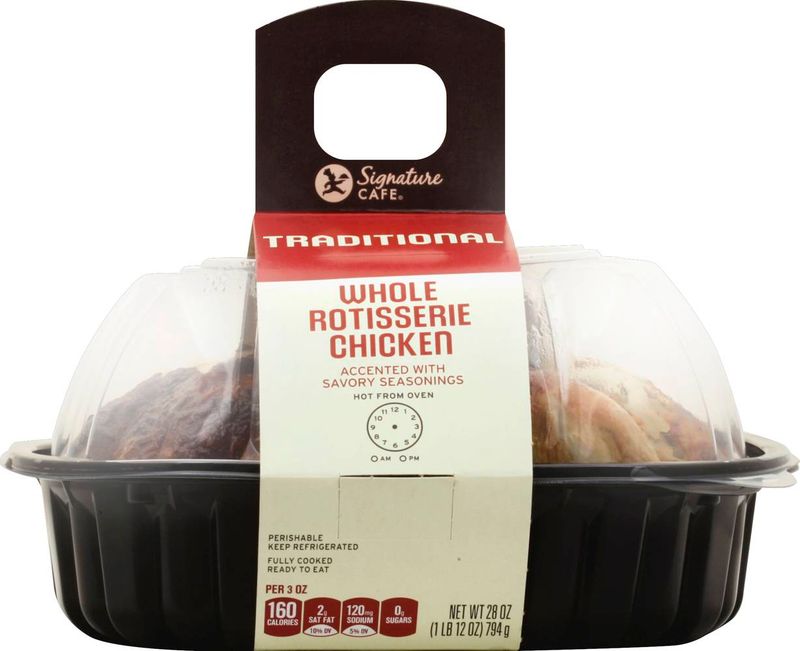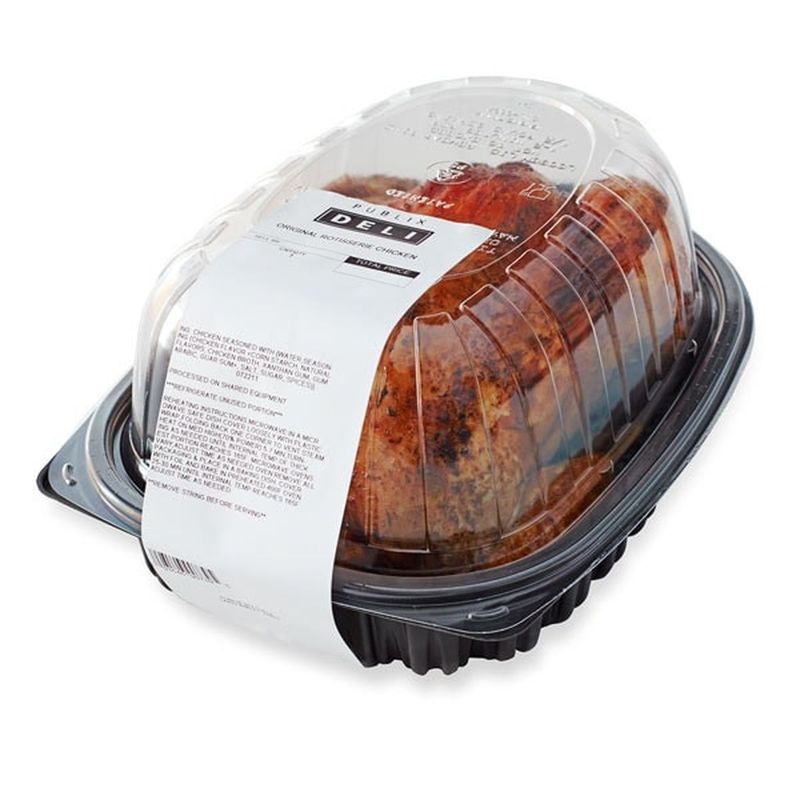12 Grocery Store Rotisserie Chickens You Should Avoid Consuming

Grocery store rotisserie chickens may seem like a convenient and tasty option, but not all are created equal. Whether due to excessive sodium, inconsistent seasoning, or questionable freshness, certain rotisserie chickens can detract from a healthy diet. This guide explores twelve such options you might want to think twice about before purchasing.
1. Walmart’s Marketside Rotisserie Chicken

Walmart’s Marketside Rotisserie Chicken often leaves customers dissatisfied due to its salty and watery profile. It’s not uncommon for people to encounter a rubbery texture, which can be quite off-putting. The chicken sometimes appears less appetizing under the bright supermarket lights, which might be a reflection of its overall quality. Shoppers have reported inconsistencies in taste, leading to a less than satisfying meal option. For those watching their sodium intake, this particular rotisserie offering might not be the best choice. It’s a reminder that convenience sometimes comes at a cost to flavor and health.
2. Sam’s Club Member’s Mark Seasoned Rotisserie Chicken

Sam’s Club Member’s Mark Seasoned Rotisserie Chicken is popular for its price, but it’s heavily injected with sodium and preservatives. This can lead to an overwhelming salty taste, which may not appeal to everyone. The excessive use of additives is a concern for those seeking natural flavor profiles. People often find the texture altered due to these injections, making the chicken less desirable. While the affordability is tempting, the health implications might be a deterrent. It’s a classic case where the initial savings might not outweigh the long-term health considerations.
3. Costco Seasoned Rotisserie Chicken

Costco’s Seasoned Rotisserie Chicken is a consumer favorite, yet its high sodium levels and processing have been flagged as health concerns. Despite its popularity, the chicken’s intense flavor can be traced back to heavy seasoning. This can detract from the natural taste, leaving a processed feel. Cost-effectiveness is a major draw, but potential buyers should weigh this against the nutritional drawbacks. In the realm of quick meals, it poses a dilemma between convenience and mindful eating. Such chickens often challenge health-conscious consumers to prioritize what’s truly important in their diet.
4. Kroger Rotisserie Chicken

Kroger Rotisserie Chicken’s reputation varies significantly across its locations. Some customers describe experiencing overly salty or dry chicken, which can make a meal quite disappointing. The seasoning is sometimes inconsistent, leading to a surprising mouthful of unexpected flavors. Such unpredictability in quality can turn a convenient purchase into a gamble. The varying preparation methods can sometimes overshadow the consistent branding one might expect from Kroger. Ensuring a delightful dining experience becomes a roll of the dice, making it a less reliable choice for those seeking consistency.
5. Safeway Signature Cafe Rotisserie Chicken

Safeway’s Signature Cafe Rotisserie Chicken often comes heavily seasoned with artificial flavorings. This can lead to an overpowering taste, which doesn’t sit well with everyone. Additionally, these chickens are frequently found sitting too long under heat lamps, affecting their tenderness and juiciness. For those preferring a more natural taste and texture, this option might fall short. The prolonged exposure to heat can lead to a less satisfying dining experience, detracting from the convenience factor. It’s an example where artificial enhancements don’t necessarily equate to improved taste.
6. Publix Traditional Rotisserie Chicken

Publix’s Traditional Rotisserie Chicken is celebrated for its quality in select areas, but the traditional flavor often falls short. Customers have noted it tends to be too salty, which can overshadow the natural taste of the chicken. The risk of drying out quickly is an issue for those who expect moist, flavorful meat. This inconsistency in texture and taste can deter those who value flavor balance. While it might offer convenience, the experience can vary, leaving some diners unsatisfied. It emphasizes the importance of quality over assumed reliability.
7. Food Lion Rotisserie Chicken

Food Lion’s Rotisserie Chicken might attract with its budget-friendly price tag, but quality is sometimes compromised. It’s often criticized for lacking moisture, which can leave the chicken tasting bland. The oily skin presents an unappealing texture to some consumers, impacting the overall meal enjoyment. Reports of inconsistent seasoning further complicate the dining experience, making it less appealing to those seeking a reliable option. For shoppers on a tight budget, it presents an affordable choice, albeit with trade-offs in taste and texture that might not meet everyone’s expectations.
8. Giant Food Stores Rotisserie Chicken

Giant Food Stores’ Rotisserie Chicken can be a hit or miss depending on the location. Customers often encounter dryness, which can detract significantly from the meal experience. The use of strong artificial seasoning blends is not universally appreciated, leading some diners to seek alternatives. This inconsistency can deter those in search of a dependable, flavorful chicken option. While it may offer convenience, the unpredictability in taste and texture can be a downside. It’s a reminder that quality can vary widely, even within the same brand, affecting overall satisfaction.
9. Albertsons Rotisserie Chicken

Albertsons Rotisserie Chicken is pre-seasoned with a chemical-heavy brine, imparting a distinctive salty flavor. This can overshadow the natural taste of the chicken, leading some to find it less appealing. The artificial flavor profile may not be a favorite for those who prefer more subtle seasoning. Additionally, the brining process can affect the chicken’s moisture level, making it less juicy than expected. Such preparation methods reflect a trend towards convenience over culinary finesse. For health-conscious consumers, the chemical additives might be a significant deterrent.
10. Piggly Wiggly Rotisserie Chicken

Piggly Wiggly’s Rotisserie Chicken showcases a varied quality, heavily dependent on the location. Some have found it greasy and poorly seasoned, which can detract from the meal’s enjoyment. This inconsistency in preparation can lead to a less than ideal dining experience. While the price might be attractive, the unpredictability in taste makes it a less dependable choice. For those seeking a consistently flavorful option, this might not be the top pick. It’s an illustration of how geographical differences can impact food quality, even within the same franchise.
11. Meijer Rotisserie Chicken

Meijer Rotisserie Chicken often presents a quality conundrum, with frequent complaints about a rubbery texture. The chicken’s high salt content can overpower its natural flavors, leaving some consumers unsatisfied. This combination of texture and taste issues may deter those in search of a more pleasant dining experience. While it offers convenience, the trade-offs in quality can be off-putting for discerning eaters. The unpredictable nature of Meijer’s rotisserie chicken makes it a gamble, reminding shoppers that not all quick meals offer the quality one might expect.
12. WinCo Rotisserie Chicken

WinCo Rotisserie Chicken is known for its affordability, but it often falls short on freshness and flavor. The chicken is perceived as overly processed, which can lead to an undesirable taste. High sodium content is another concern, making it less suitable for those monitoring their salt intake. The convenience factor might attract some shoppers, but the quality trade-offs are apparent. This emphasizes the importance of balancing cost against culinary satisfaction. For those who value taste over price, WinCo’s offering might not meet their expectations, highlighting the complexities of grocery shopping choices.
